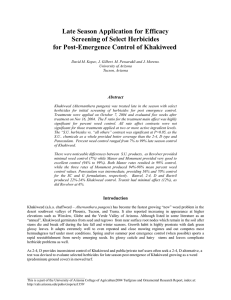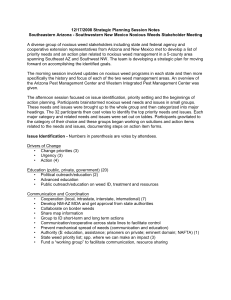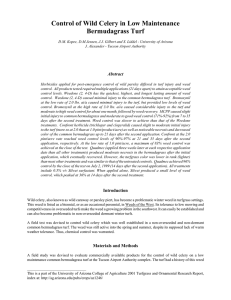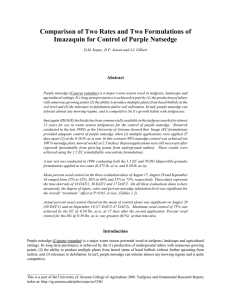Penoxsulam as a Potential Post-Emergence for Khakiweed (Alternanthera pungens) Abstract
advertisement
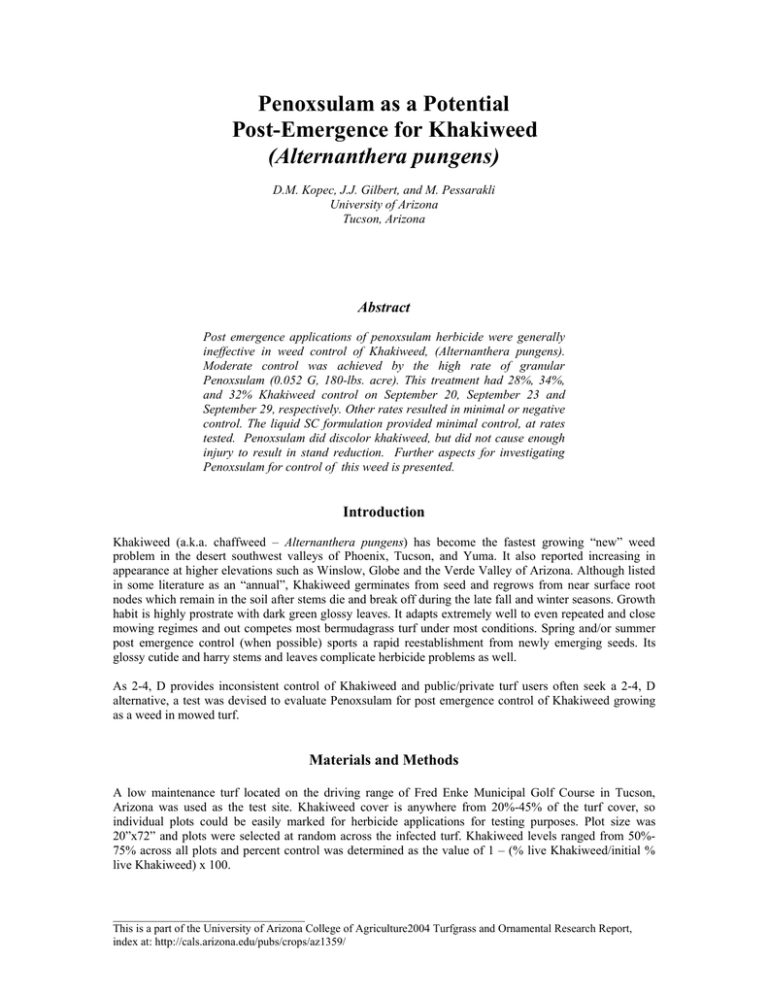
Penoxsulam as a Potential Post-Emergence for Khakiweed (Alternanthera pungens) D.M. Kopec, J.J. Gilbert, and M. Pessarakli University of Arizona Tucson, Arizona Abstract Post emergence applications of penoxsulam herbicide were generally ineffective in weed control of Khakiweed, (Alternanthera pungens). Moderate control was achieved by the high rate of granular Penoxsulam (0.052 G, 180-lbs. acre). This treatment had 28%, 34%, and 32% Khakiweed control on September 20, September 23 and September 29, respectively. Other rates resulted in minimal or negative control. The liquid SC formulation provided minimal control, at rates tested. Penoxsulam did discolor khakiweed, but did not cause enough injury to result in stand reduction. Further aspects for investigating Penoxsulam for control of this weed is presented. Introduction Khakiweed (a.k.a. chaffweed – Alternanthera pungens) has become the fastest growing “new” weed problem in the desert southwest valleys of Phoenix, Tucson, and Yuma. It also reported increasing in appearance at higher elevations such as Winslow, Globe and the Verde Valley of Arizona. Although listed in some literature as an “annual”, Khakiweed germinates from seed and regrows from near surface root nodes which remain in the soil after stems die and break off during the late fall and winter seasons. Growth habit is highly prostrate with dark green glossy leaves. It adapts extremely well to even repeated and close mowing regimes and out competes most bermudagrass turf under most conditions. Spring and/or summer post emergence control (when possible) sports a rapid reestablishment from newly emerging seeds. Its glossy cutide and harry stems and leaves complicate herbicide problems as well. As 2-4, D provides inconsistent control of Khakiweed and public/private turf users often seek a 2-4, D alternative, a test was devised to evaluate Penoxsulam for post emergence control of Khakiweed growing as a weed in mowed turf. Materials and Methods A low maintenance turf located on the driving range of Fred Enke Municipal Golf Course in Tucson, Arizona was used as the test site. Khakiweed cover is anywhere from 20%-45% of the turf cover, so individual plots could be easily marked for herbicide applications for testing purposes. Plot size was 20”x72” and plots were selected at random across the infected turf. Khakiweed levels ranged from 50%75% across all plots and percent control was determined as the value of 1 – (% live Khakiweed/initial % live Khakiweed) x 100. __________________________________ This is a part of the University of Arizona College of Agriculture2004 Turfgrass and Ornamental Research Report, index at: http://cals.arizona.edu/pubs/crops/az1359/ Twelve treatments and an UTC were included in a RCB design with three replications. Liquid (SC formulation) applications of Penoxsulam were applied using an 8004 E nozzle, applying a 52 GPA final solution delivery rate. A 0.5% non-ionic surfactant (90%) was included in the SC and any other liquid treatment. Granular treatments were applied using a hand shaker (4-5 passes across plot). Treatments were applied on September 9, 2004 at 6:15 AM on wet turf (dew and brief irrigation). Treatments were then allowed to dry completely on the leaves for 14 hours, followed by an irrigation of ¼-3/8 inch. Plots were scored on September 14, September 23 and September 29 for percent live and dead Khakiweed on a 100% per plot basis. Percent live Khakiweed in time was used for weed control (described earlier). Degree of injury scores using a 1-6 subjective scale (1 = no injury, 4 = moderate injury, and 6 = severe injury) were also applied to plots on the same education dates. All date was subjected to the analysis of variance technique (ANOVA) using SAS mainframe software. Orthogonal polynomials were used for single degree of freedom test for rate effects of Penoxsulam. Linear, quadratic and cubic contrasts were tested for each formulation type. A contrast was also devised to test “all SC formulations” vs. “ all G formulations.” For comparison of all treatments at large, an LSD value was calculated as the mean treatment separation statistic only if the F ratio for the overall treatment main effect was significant at P = 0.05, or less. Results and Discussion The calculated percent weed control response was not significant in relationship to treatments on any of the three evaluation dates. Nor were any of the single degree of freedom orthogonal contrasts significant at any time. The visible response of degree of injury was significant on one of four evaluations (23 September, 2004) (Table 1). Percent control was minimal, as certain treatments experienced increased plot cover in Khakiweed after treatment. These plots thus have negative control mean values in Table (1). Treatments that had no or negative control included both the SC product formula, as well as the granular formulation that included nitrogen fertilizer. Likewise, negative or positive responses were not rate dependent in response. Moderate control was achieved by the high rate of granular Penoxsulam (0.052 G, 180-lbs. acre). This treatment had 28%, 34%, and 32% Khakiweed control on September 20, September 23 and September 29, respectively. At the next highest application of the granular formulation (0.034 GR, 180-lbs. acre) percent control went from 10%, -2%, to –46% control throughout the test. The third highest rate of granular (0.023 G, 180 lbs. acre) provided 31%, 11%, and –9% control on the three evaluated dates, respectively. In the case of the G applications, the two highest rates offered some control, but not to a large degree. If the product is (in part?) taken up through the soil, than the G formula might have had better weed control after the 14 hour post irrigation application if more active ingredient was preserved in remaining granules, versus a liquid formulation, which would be more susceptible to atmospheric degradation. Still, the single degree of freedom contrast comparing all granular vs. all liquid applications of Penoxsulam was not significant. At large, the SC formulations had no control whatsoever. There are three ways to investigate this phenomenon. (1) Apply both materials to only soils, foliage, and both, or (2) increase rates, or (3) switch to a silicone base surfactant. In theory, this should provide better cuticle penetration. Both the Trimec Classic EC and Green Power fertilizer/Trimec G formulations provided no control. Khakiweed appears “annually” from rooted stem nodes and as new seedlings. If weed age and maturity affect efficacy, than repeat applications would most likely be needed none the less if the materials are applied “early” in mid-spring or early summer. The degree of injury response had F ratio P values as follows: P = 0.15 on 9 September, P = 0.16 on 20 September, P = 0.06 on 23 September, and P = 0.20 on 29 September, 2004 (Table 1). There was some injury to Khakiweed from Penoxsulam, which caused a light bleached coloration and loss of stem color. In general, both of the highest rates of the SC and G formulations caused the highest degree of injury scores (in general rank and which was also significant on September 23, 1004). Again, the highest rate of the G formulation caused more visible injury to Khakiweed than did the highest (SC) rate application. Again, the potential of increased rates seems plausible, while the use of increased surfactant activity may affect the SC performance. Both are unknown at this time. As the test side was vastly “weedy”, it was not possible to assess turf tolerance to formulations and rates tested here. This is another important aspect of product evaluation as well. FN: KHAKDOW1.DOC Q 4 04 tosh FN: khakidow2004.xls q 404 tosh Table 1. Perecent weed control and degree of injury to Khakiweed (Alternanthera pungens) after post emergence applications of Penoxsulam and other select herbicides. University of Arizona, 2004. % weed control TREATMENT PENOX2 SC @ 0.01 lb ai/a ' PENOX 2 SC @ 0.02 lb ai/a' PENOX 2 SC @ 0.04 lb ai/a' PENOX 2 SC @ 0.06 lb ai/a' PENOX 2 SC @ 0.09 lb ai/a' PENOX FERT 0.006 GR @ 180 lb pr/a' PENOX FERT 0.011 GR @ 180 lb pr/a ' PENOX FERT 0.023 GR @ 180 lb pr/a' PENOXFERT 0.034 GR @ 180 lb pr/a' PENOX FERT 0.052 GR @ 180 lb pr/a' TRIM CLASS 3.32 EC @ 4 pt pr/a' GRN POWR fert / trimc GR @ 156 lb pr/a' TEST MEAN (3) LSD VALUE (4) (1) 20-Sep 23-Sep (18 DAT) (21 DAT) -10.7 -11.3 20.5 7.7 14.9 -8.3 -13.1 -33.9 -18.3 12.2 -12.5 -9.7 -2.2 -4.8 30.6 11.2 10.7 -2.6 28.3 34.3 -5.7 -19.0 19.5 -1.0 Degree of injury 29-Sep (27 DAT) 9.5 10.3 -37.7 -26.7 -24.6 -19.2 5.2 -9.5 -45.8 32.3 0.8 2.1 9-Sep (7 DAT) 1.7 2.3 1.7 2.7 2.0 1.7 1.3 1.7 1.7 2.3 1.3 1.3 20-Sep 23-Sep 29-Sep (18 DAT) (21 DAT) (27 DAT) 1.0 1.0 1.3 2.3 2.3 1.7 2.3 2.0 1.3 2.7 1.7 1.3 3.0 2.7 1.7 1.7 1.7 1.3 2.3 2.0 1.7 2.3 2.3 2.0 2.0 1.7 1.7 3.3 3.0 2.7 1.7 1.7 2.0 2.0 1.7 1.3 5.2 -2.1 -8.6 1.8 2.2 2.0 1.7 ns ns ns ns ns 1.0 0.9 1 Percent weed control; . Values are the mean of three replications. Treatments appled Sept 7, 2004. 2. Degree of injury to weeds. (1-6) . 1= none; 4= moderate; 6= severe. Values are the mean of three replications. 3 Test mean. Average of all treatments on each evaluation date. 4 LSD Value = tretament mean separation statistic. Absoulte differences between two treatments must be larger than the LSD value for trteaments to be significantly different from each other (2)


